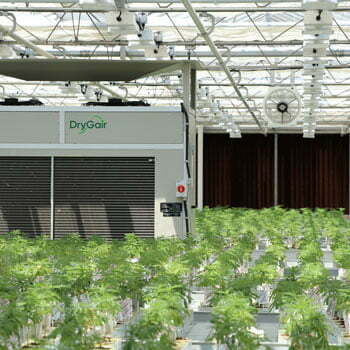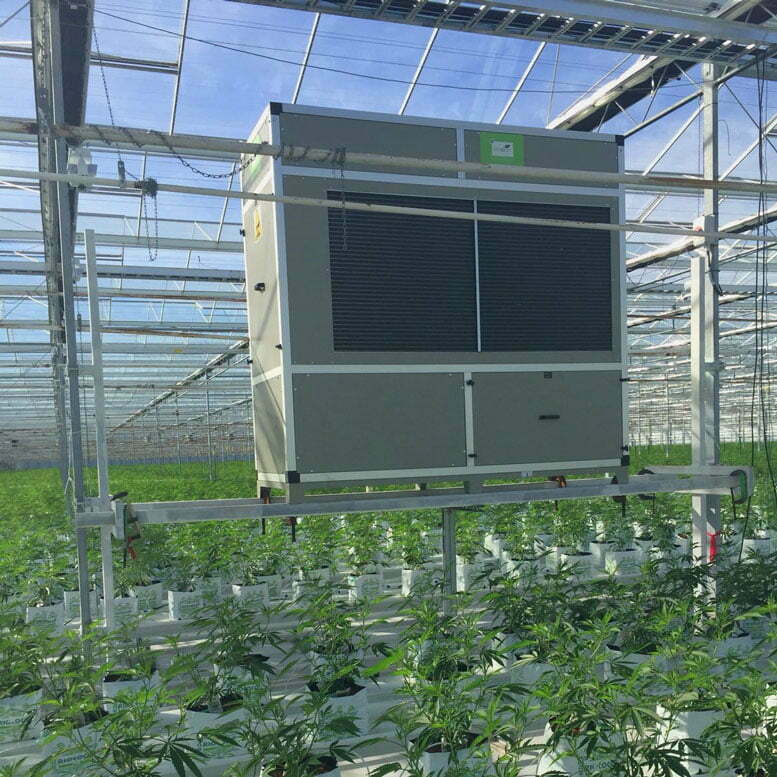


Botrytis is an extremely common disease in cannabis cultivation, also known as bud rot or gray mold.
What Is Botrytis?
Botrytis cinerea, aka gray mold or bud rot, is a common type of mold and the most common humidity related disease in cannabis plants. It’s a fungal pathogen that affects a variety of crops such as tomatoes, cucumbers, peppers, basil and roses, and of course – cannabis buds.
Cannabis Is Highly Sensitive to Humidity
Growing cannabis in a closed space requires a highly regulated environment. Without proper climate control, the space will become extremely humid. This is due to the fact that plants constantly transpire water.
Without humidity control, the water vapor builds up in the air, causing relative humidity to rise. Once the air is saturated, the dew point is reached, and water begins to condense. The appearance of water is the number one cause for botrytis outbreaks.
When it comes to cannabis, the threat is much greater. The dense buds create the perfect humidity trap. Trapped water vapor builds up and can eventually condense inside the bud, leading botrytis to develop where it’s most harmful. The rest of the plant is susceptible to mold as well, but the buds are at the highest risk.
Needless to say, moldy cannabis is unfit for consumption. It also doesn’t meet legal regulations for distribution or further processing, neither for medical purposes nor recreational.
It’s important to note that bud rot poses a threat at all stages of cannabis production. This includes post-harvest processes, such as drying, curing and even after packaging.
Identifying Botrytis
Botrytis is a mold that can develop on any part of the plant other than the roots – leaves, stems, flowers and fruit.
Botrytis infections can be recognized by the appearance of gray, dusty spores with a velvety appearance. The tissue on which gray mold develops becomes dark and sometimes soft, as it kills the plant’s cells.
The biggest problem with botrytis identification, is that once it becomes apparent, the mold has already penetrated the plant. At this point, it’s extremely difficult to treat.
Additionally, once bud rot develops, it begins releasing spores, infecting additional plants. This makes bud rot very dangerous, especially in dense grow rooms.
Preventing Botrytis in Cannabis
Treating botrytis after the fact is nearly impossible and unfeasible in large-scale cultivation. The best way to avoid botrytis outbreaks is by preventing its development, rather than treating infected plants.
While there are many ways to prevent bud rot, the best, most reliable method, is to control humidity and reduce the presence of water.
In order to develop, botrytis requires water. Besides irrigating cautiously, avoiding water is all about controlling humidity. If relative humidity reaches 100%, even in a small area, botrytis can develop. A minor outbreak can quickly evolve into a large-scale infection of the entire space.
Maintaining a comfortable relative humidity level of 60%-80% helps ensure that water won’t condense in the grow room.
It’s also important to maintain an even climate. As mentioned, a small local outbreak can lead to further infections, so maintaining a uniform climate is crucial.
Using DryGair to Prevent Botrytis in Cannabis
Controlling humidity in cannabis greenhouses and grow rooms is the number one method to prevent botrytis. So using dehumidification is the only sure-fire way to reduce and even eliminate botrytis outbreaks.
DryGair is designed specifically for this purpose. It provides efficient, high-capacity water extraction, with a large coverage area, fit for commercial cannabis cultivation, and botrytis prevention.
Using DryGair in Cannabis Cultivation has Several Added Benefits:
- Collect and use extracted water
- Save energy compared to HVAC or heating and venting
- Patented air circulation system for climate uniformity
- Fast return on investment





